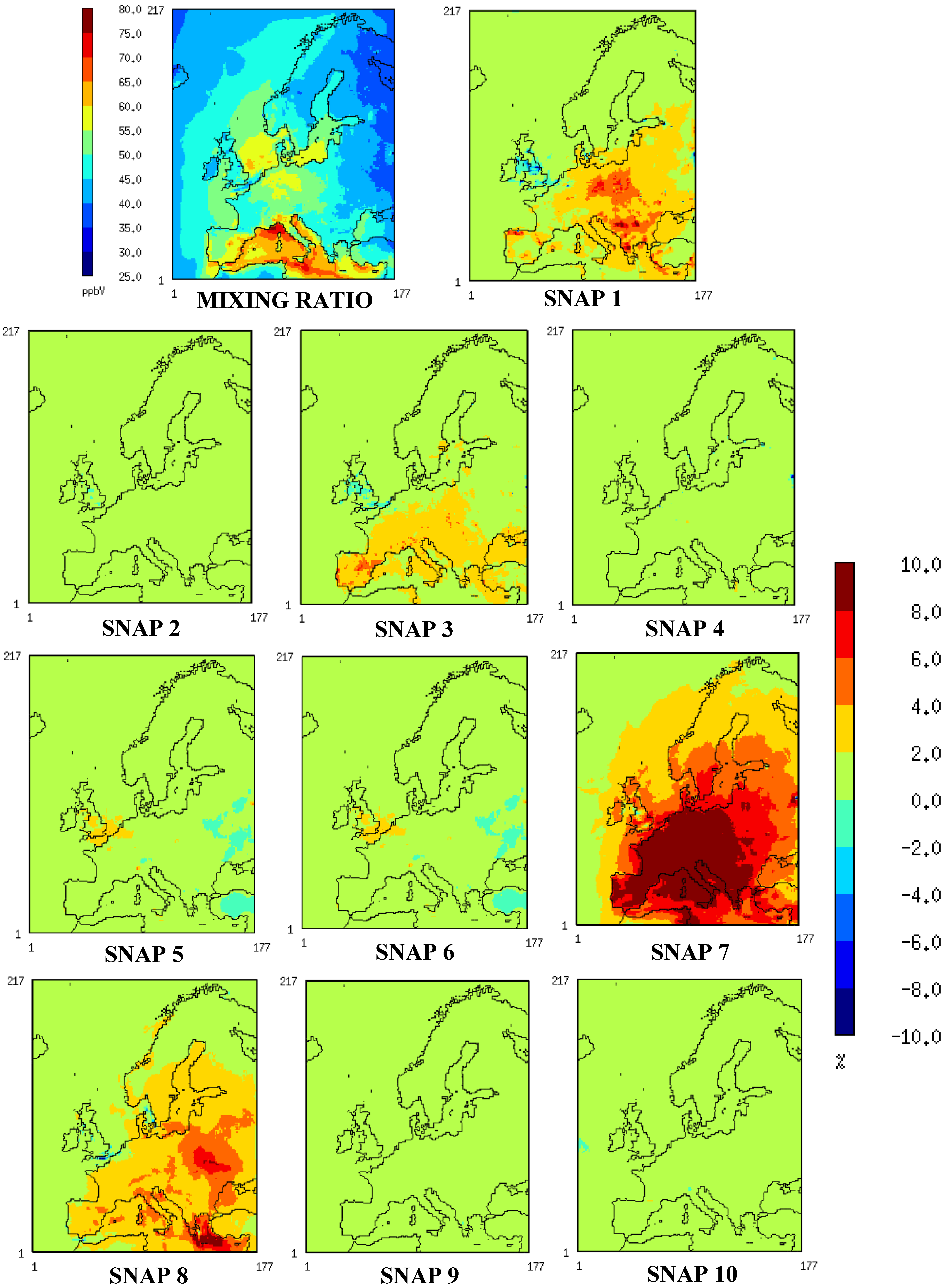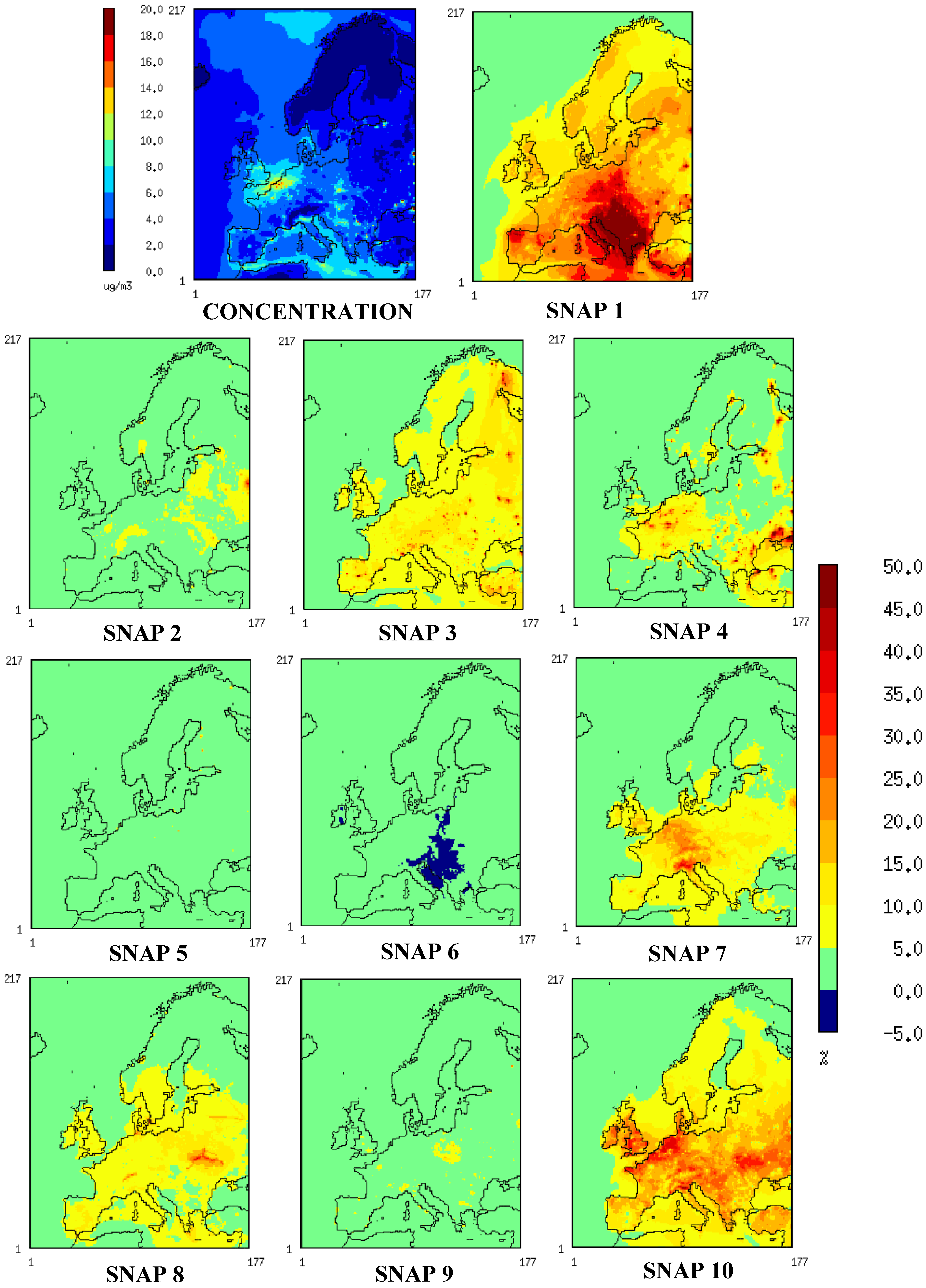Effect of the Standard Nomenclature for Air Pollution (SNAP) Categories on Air Quality over Europe
Abstract
:1. Introduction
2. Method
Meteorology
Emissions
Air Quality Modeling

3. Results and Discussion



4. Conclusions
Acknowledgments
Author Contributions
Conflicts of Interest
References
- Karnosky, D.F.; Skelly, J.M.; Percy, K.E.; Chappelka, A.H. Perspectives regarding 50 years of research on effects of tropospheric ozone air pollution on US forests. Environ. Pollut. 2007, 147, 489–506. [Google Scholar] [CrossRef] [PubMed]
- Raaschou-Nielsen, O.; Andersen, Z.J.; Beelen, R.; Samoli, E.; Stafogia, M.; Weinmayr, G.; Hoffmann, B.; Fischer, P.; Nieuwenhuijsen, M.J.; Brunekreef, B.; et al. Air pollution and lung cancer incidence in 17 European cohorts: Prospective analyses from the European Study of Cohorts for Air Pollution Effects (ESCAPE). Lancet Oncol. 2013, 14, 813–822. [Google Scholar] [CrossRef]
- Greenberg, J.P.; Guenther, A.; Zimmermann, P.; Baugh, W.; Geron, C.; Davis, K.; Helmig, D.; Klinger, L.F. Tethered balloon measurements of biogenic VOCs in the atmospheric boundary layer. Atmos. Environ. 1999, 33, 855–867. [Google Scholar] [CrossRef]
- Seinfeld, J.; Pandis, S.N. Atmospheric Chemistry and Physics; John Wiley: Hoboken, NJ, USA, 2006; p. 720. [Google Scholar]
- SNAP—Standard Nomenclature for Air Pollution categories. Available online: www.emep.int/UniDoc/node7.html (accessed on 28 July 2015).
- Kuenen, J.; van der Gon, H.D.; Visschedijk, A.; Dröge, R.; van Gijlswijk, R. MACC European Emission Inventory for the Years 2003–2007; The Netherlands Organisation Report, TNO-060-UT-2011-00588; Utrecht, The Netherlands, 2011; p. 49. [Google Scholar]
- Aksoyoglu, S.; Keller, J.; Oderbolz, D.C.; Barmpadimos, I.; Prevot, A.S.H.; Baltensperger, U. Sensitivity of ozone and aerosols to precursor emissions in Europe. Int. J. Environ. Pollut. 2012, 50, 451–459. [Google Scholar] [CrossRef]
- Megaritis, A.G.; Fountoukis, C.; Charalampidis, P.E.; Pilinis, C.; Pandis, S.N. Response of fine particulate matter concentrations to changes of emissions and temperature in Europe. Atmos. Chem. Phys. 2013, 13, 3423–3443. [Google Scholar] [CrossRef]
- Tagaris, E.; Sotiropoulou, R.E.P.; Gounaris, N.; Andronopoulos, S.; Vlachogiannis, D. Air quality over Europe: Modeling gaseous and particulate pollutants. Atmos. Chem. Phys. 2013, 13, 9661–9673. [Google Scholar] [CrossRef]
- Grell, G.; Dudhia, J.; Stauffer, D.R. A Description of the Fifth Generation Penn State/NCAR Mesoscale Model (MM5); NCAR Tech. Note, NCAR/TN-398+STR; NCAR: Boulder, CO, USA, 1994; p. 128. [Google Scholar]
- Byun, D.W.; Schere, K.L. Review of the governing equations, computational algorithms, and other components of the Models-3 Community Multscale Air Quality CMAQ) modeling system. App. Mech. Rev. 2006, 59, 51–77. [Google Scholar] [CrossRef]
- Foley, K.M.; Roselle, S.J.; Appel, K.W.; Bhave, P.V.; Pleim, J.E.; Otte, T.L.; Mathur, R.; Sarwar, G.; Young, J.O.; Gilliam, R.C.; et al. Incremental testing of the Community Multiscale Air Quality (CMAQ) modeling system version 4.7. Geosci. Model Dev. 2010, 3, 205–226. [Google Scholar] [CrossRef]
- Vautard, R.; Moran, M.D.; Solazzo, E.; Gilliam, R.C.; Matthias, V.; Bianconi, R.; Chemel, C.; Ferreira, J.; Geyer, B.; Hansen, A.B.; et al. Evaluation of the meteorological forcing used for the Air Quality Model Evaluation International Initiative (AQMEII) air quality simulations. Atmos. Environ. 2012, 53, 15–37. [Google Scholar] [CrossRef] [Green Version]
- AQMEII - Air Quality Modelling Evaluation International Initiative. Available online: http://aqmeii.jrc.ec.europa.eu (accessed on 28 July 2015).
- Byun, D.W.; Pleim, J.E.; Tang, R.T.; Bourgeois, A. Meteorology-Chemistry Interface Processor (MCIP) for Models-3 Community Multiscale Air Quality (CMAQ) Modeling System. In Science algorithms of the EPA Models-3 Community Multiscale Air Quality (CMAQ) Modeling System. US Environmental Protection Agency Report; EPA-600/R-99/030, 12-1-12-91; EPA: Washington, DC, USA, 1999. [Google Scholar]
- SMOKE—Sparse Matrix Operator Kernel Emissions modeling system. Available online: www.smoke-model.org/index.cfm (accessed on 28 July 2015).
- van der Gon, H.D.; Hendriks, C.; Kuenen, J.; Segers, A.; Visschedijk, A. Description of Current Temporal Emission Patterns and Sensitivity of Predicted AQ for Temporal Emission Patterns; TNO Report, EU FP7 MACC Deliverable Report D_D-EMIS_1.3; Utrecht, The Netherlands, 2011; p. 22. [Google Scholar]
- Tagaris, E.; Sotiropoulou, R.E.P.; Gounaris, N.; Andronopoulos, S.; Vlachogiannis, D. Impact of biogenic emissions on ozone and fine particles over Europe: Comparing effects of temperature increase and a potential anthropogenic NOx emissions abatement strategy. Atmos. Environ. 2014, 98, 214–223. [Google Scholar] [CrossRef]
- Yarwood, G.; Rao, S.; Yocke, M.; Whitten, G.Z. Updates to the Carbon Bond Chemical Mechanism: CB05; Final Report to the US Environmental Protection Agency, RT-0400675; Research Triangle Park, NC, USA, 2005; p. 246. [Google Scholar]
- Baker, K.R.; Kelly, J.T. Single source impacts estimated with photochemical model source sensitivity and apportionment approaches. Atmos. Environ. 2014, 96, 266–274. [Google Scholar] [CrossRef]
- Kwok, H.F.; Baker, K.R.; Napelenok, S.L.; Tonnesen, G.S. Photochemical grid model implementation and application of VOC, NOx, and O3 source apportionment. Geosci. Model Dev. 2015, 8, 99–114. [Google Scholar] [CrossRef]
- Directive 2008/50/EC of the European Parliament and of the Council of 21 May 2008 on ambient air quality and cleaner air for Europe. Available online: http://eur-lex.europa.eu/legal-content/EN/TXT/PDF/?uri=CELEX:32008L0050&from=%20EN (accessed on 28 July 2015).
- Brandt, J.J.; Silver, D.; Christensen, J.H.; Andersen, M.S.; Bønløkke, J.; Sigsgaard, T.; Geels, C.; Gross, A.; Hansen, A.B.; Hansen, K.M.; et al. Contribution from the ten major emission sectors in Europe to the Health-Cost Externalities of Air Pollution using the EVA Model System-an integrated modelling approach. Atmos. Chem. Phys. 2013, 13, 7725–7746. [Google Scholar] [CrossRef]
© 2015 by the authors; licensee MDPI, Basel, Switzerland. This article is an open access article distributed under the terms and conditions of the Creative Commons Attribution license (http://creativecommons.org/licenses/by/4.0/).
Share and Cite
Tagaris, E.; Sotiropoulou, R.E.P.; Gounaris, N.; Andronopoulos, S.; Vlachogiannis, D. Effect of the Standard Nomenclature for Air Pollution (SNAP) Categories on Air Quality over Europe. Atmosphere 2015, 6, 1119-1128. https://doi.org/10.3390/atmos6081119
Tagaris E, Sotiropoulou REP, Gounaris N, Andronopoulos S, Vlachogiannis D. Effect of the Standard Nomenclature for Air Pollution (SNAP) Categories on Air Quality over Europe. Atmosphere. 2015; 6(8):1119-1128. https://doi.org/10.3390/atmos6081119
Chicago/Turabian StyleTagaris, Efthimios, Rafaella Eleni P. Sotiropoulou, Nikos Gounaris, Spyros Andronopoulos, and Diamando Vlachogiannis. 2015. "Effect of the Standard Nomenclature for Air Pollution (SNAP) Categories on Air Quality over Europe" Atmosphere 6, no. 8: 1119-1128. https://doi.org/10.3390/atmos6081119





